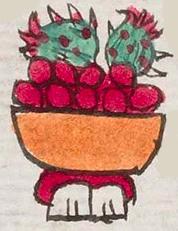Nocheztlan (Mdz15v)
This compound glyph for the place name Nocheztlan ("Near the Cochineal") features a bowl of cochineal (nocheztli), the red dye. It is not uncommon for the letters "e" and "i" to be somewhat interchangeable, so Nochiztlan would be an acceptable orthographic variant. The locative suffix (-tlan) in the place name is represented phonetically by the teeth (tlantli). The basket of cochineal has two cactus fruits (nochtli) sitting on top. This may be an iconographic clue that the bowl had cochineal in it compared to, perhaps, achiotl (achiote, a food seasoning).
Stephanie Wood
Incidentally, the name for cochineal seems to combine nochtli cactus fruit with eztli (blood), which makes sense given that it is a red dye. When the cochineal insect is squished on one's hand, it appears to be like blood. See below, right for the bowl of achiotl, for comparison. It is also red.
Stephanie Wood
nochiztlan. puo
Nocheztlan, pueblo
Stephanie Wood
c. 1541, or by 1553 at the latest
Stephanie Wood
cactus fruits, cactus blood, red dyes, cochineal, insects

nochez(tli), cochineal, a red dye, https://nahuatl.wired-humanities.org/content/nocheztli
noch(tli), cactus fruit, https://nahuatl.wired-humanities.org/content/nochtli
ez(tli), blood, https://nahuatl.wired-humanities.org/content/eztli
-tlan (locative suffix), place, https://nahuatl.wired-humanities.org/content/tlan
Cerca [del Lugar] de la Cochinilla
Stephanie Wood
Codex Mendoza, folio 15 verso, https://digital.bodleian.ox.ac.uk/objects/2fea788e-2aa2-4f08-b6d9-648c00..., image 41 of 188.
The Bodleian Libraries, University of Oxford, hold the original manuscript, the MS. Arch. Selden. A. 1. This image is published here under the UK Creative Commons, “Attribution-NonCommercial-ShareAlike 3.0 License” (CC-BY-NC-SA 3.0).








